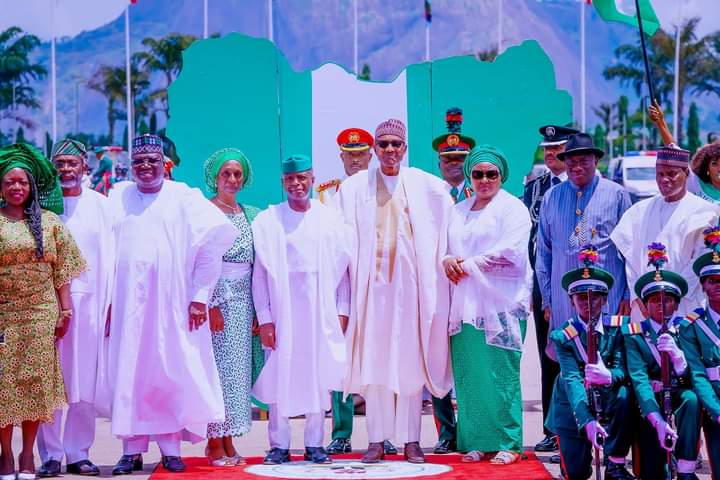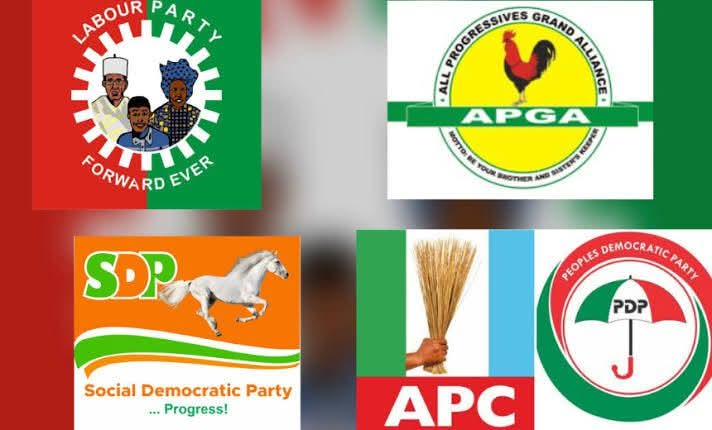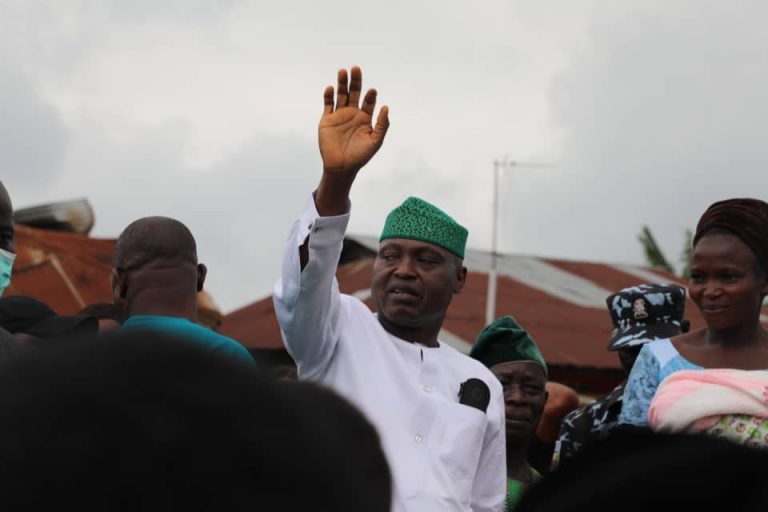Yesterday, it was 62 years since Nigeria got her independence from colonial Britain. While some countrymen say the October 1 celebration rituals are worthy of flinging the cymbals, some others say it is a day to drench ourselves in sack clothes and ashes reminiscent of mourning moments for biblical Israelites. For decades, until the October 1 saturnalia began to lose its savour, successive governments made a good job of conflating the frills of the rituals as a representation of our national joy and unity. Children looked forward to the symphony of the National Day orchestra, the perfect chemistry of matching feet at stadia across the country and the arresting drums of police bands.
A musical rendition of this October 1 ritual that succinctly captures its mesmerizing glee is in the 1971 recorded vinyl of Ligali Mukaiba, Yoruba Apala musician. Mukaiba, widely known as Baba L’Epe, having been born in the riverine Epe area of Lagos, was a musical petrel of the 1960s, through the 1980s. He had a mellifluous and almost effeminate voice that singled him out among his peers. He was a social crusader, commentator and musical prodigy, serenading Nigerian fans and the west coast with his very sublime, penetrating Apala music. I am yet to listen to a more penetrating account of the Midas touch, arresting power and talismanic power of the female gender as evocatively delivered by Mukaiba in the track he entitled ‘Kurukere’. He sang that when a woman’s love “enters the head” of a man – bo ba nwuni, to ba nj’araba eni, he called it, she destabilises all his organs of reasoning and he begins to act in dissonance with his actual person. Sorry, I digressed.
In the song entitled ‘Eyi Yato’ (This is different) wherein he had the particular track called ‘Ominira’ – independence – Mukaiba narrated what transpired on October 1, 1971, at the Race Course. It was where the Union Jack was lowered 11 years earlier and which was eventually named the Tafawa Balewa Square, after the murder of Nigeria’s personable first prime minister.
“Eleven years after our independence, the celebration this year was in a class of its own,” Mukaiba sang in his unique and distinct voice. In a very faint, cascading and tremulous voice, he conjured the images of aeroplanes in the sky on parade that day. According to him, the planes were swivelling like an okoto, a traditional children’s game played in sand dunes in Yorubaland up until about the 1980s. In the Ayo okoto contest, each player spins the cylindrical object, which makes undulating swivels until it stops. Mukaiba said that, like the Okoto, the aeroplanes flew low as if they were landing and almost immediately, flew back to the sky again as if they were toys. To represent this toy-like fiddling with the aeroplanes by the pilots, Mukaiba sang: “Bo’ya won a d’oriko’do, bo tun ya won a ko’ri s’oke”. Before Mukaiba could internalise this mysterious demonstration, he said, the aeroplanes would fly higher again, serenading the head of state, Yakubu Gowon, who was excited at this display at the Race Course.
Pupils and students of various schools, according to Mukaiba in that track, did very enlivening march pasts to mark the October 1 ritual. Boys’ Scouts and soldiers also marched, with their hands and feet doing amazing synchrony and their shoes, according to Mukaiba, speaking different grammar “bata nso orisisirisi oyinbo lenu won”. He captured cyclists too who cycled from Race Course to Ikeja in amazing wondrous displays of their cycling skills. For him, what attracted him most was the “dekoreti – decoration” of flags everywhere on cranes in Lagos. Soldiers’ guns, he said, were in deafening ricochets. One time, they would march to a side and then backwards. Mukaiba ended the track by introducing a lewd touch to the song. He was so fascinated by – ostensibly the scientific movements of soldiers’ feet on parade – that he wanted to immediately join the army but for his wife who held on to the nape of his cloth in disagreement – “Sailensi ise t’an npe lo ti e wu mi o; mo ti fe lo si soja, iyawo mi lo gba mi mu lewu ni o je ki’un lo“.
October 1 celebrations, which have become perennial rituals in Nigeria, respect for the Nigerian flag, the national anthem and many more, are some of the totems that successive governments use as objects of nation-building. States that covet nationhood deploy these totems to unify their fractious people. It is why the framers of Nigeria’s erstwhile national anthem wrote that “though tribe and tongue may differ…”
Many countries have within them nations which spill over identified boundaries into multiple states. The Fulani and Yoruba nations are examples. The Yoruba nation spills over to some states in West Africa like the Benin Republic and Togo while the Fula nation, known as Fulani, courses through Lake Chad in the east to the Atlantic coast but is concentrated principally in Nigeria, Mali, Guinea, Senegal, and Niger.
Nigeria’s fragile togetherness has since worsened. Nigerians are daily being ostracised from Nigeria. This is done by the government promoting the prime place of ethnicity over the others.
Two very instructive fables speak to what led us to this precipice. In those fables, we are covertly told that when more than one people come together, with recognised differences, there must be mutual respect for one another, equity and a sense of rightness. The absence of these factors has led Nigeria’s disparate peoples to go their separate ways in spirit. The two fables got promoted in the songs of Ibadan-born Awurebe music singer, Dauda Akanmu Adeeyo, popularly known as Epo Akara.
The first fable, as narrated by Epo Akara, happened in the animal kingdom where both the Partridge, a bird which the Yoruba call Aparo and the Crab, Alakan or Akan, held occupied territories, with each controlling his own resources. While each was doing well in his own sphere, they both reckoned that there was the need to forge togetherness so that their lots could be better catered for and they could grow stronger in shared resources. While the Aparo superintended over a government bountiful in yam resources, the Alakan’s government had abundant water resources. Hitherto, each and their children required what the other had.
Coalescing their thoughts, one day, they held a conference between the two nationalities. It was not as haphazard and self-serving as Lord Lugard’s Britain did. Britain, you will recall, covertly used a trade gimmick to purchase Nigeria. History tells us that Turbman Goldie wanted a single Nigerian commercial empire for his Royal Niger Company, while Fredrick Lugard wanted to safeguard British colonial trade interest in Nigeria. Unfortunately, freed slaves like Ajayi Crowther and an itinerant religious bigot like Uthman Dan Fodio who wanted to religionise the whole of the swath of lands in Nigeria helped to reinforce this colonial mission. Crowther and Fodio were protecting their creed as a single dominant religion. Crowther engaged in itinerant evangelism, from Lokoja to Onitsha while Fodio imposed mini-colonialism on disparate, far-flung Hausa states made up of different peoples, with the aim of forging them into a monolithic state. These four people – Lugard, Goldie, Crowther and Fodio – quests forcibly bound peoples of different cultures, philosophies, worldviews and languages into an inconvenient, hostile and pseudo nationality.
On their own, Aparo and Alakan sat at the table to discuss theirs and the futures of their offspring unborn. Aparo spoke first. He recognized that each of them had limitations in resources. After consuming the barn of yams located within his borders, Aparo said, he would need water to wash down the meal. Could Alakan open up his borders for him and his children to have access to his aquatic territory while he too would open his barns for his children to have easy access to yams?
They both saw the shared opportunities in this coming together. The deal was sealed and delivered, the next day, Aparo flew into the Alakan territory with his children and they fetched gallons of water. They did this for weeks. However, in the third week, Alakan sent his children to go to Aparo’s farm to harvest yams for the family’s consumption. At the farm, Alakan’s children shouted his name and he replied garrulously, in the words of Epo Akara, “Ta ni np’Aparo?” – who is calling Aparo? And those ones replied, “Omo Akan ni” – we are the children of Alakan. Then Aparo flew into a rage, calling their father unprintable names. Alakan, in the expletives from Aparo, was unevenly shaped by the Creator, with hands and legs shaped like pincers, a boulder for chest, deceptive strides such that he walks awkwardly – “O s’oju hati-hati, o s’ese hati-hati, ab’apata laya, owo meji bi emu…”
Incensed by this sudden flouting of relational terms of agreement by Aparo, Alakan’s children went back to their father and reported their encounter with him. Convinced that they had misrepresented what transpired, Aparo himself left the river bank where he was busy with some aquatic assignments and went into the forest to meet with Aparo. The partridge repeated the same excoriation. In anger, Alakan and his children came back home and that was the end of this attempt to forge a nationality from their disparate territorial leanings.
The other allegory as told by Epo Akara in another song was the consort of four animals who came together in mutual understanding of their strengths and weaknesses. They were Lion, Hyena, Cobra and Tortoise. At the conference they held, each confessed his weakness to the others. The Lion was the first to speak. “If I am in the forest hunting, no one must dare behold my face,” he charged. Anyone who dared this, said the Lion, would have death as recompense – “enikeni to ba dan wo, Asalailu ni o si mon lo,” said Epo Akara.
For Hyena, no one must spill sand on his sacred body. The Cobra cleared his throat and said, “You could step on my head and I will keep mute; step on my back with no blowback but anyone who steps on my tail will die”. The Tortoise on his own told his fellow conferees that backbiting was his major put-off. Anyone who does this to him provokes the beast in him.
For decades, they lived in amity and hunted games collectively. However, one day, they sent Tortoise on an errand. Assuming he was not within hearing shot, the Hyena cleared his throat and began to speak. He bemoaned the Tortoise’s self-righteousness, stating, in that deep Yoruba aphorism, that everyone could haggle with the launderer but not an Ato’le – one stricken by incontinence of bedwetting.
The next day, as they were hunting in the forest, Tortoise then provoked a dissembling. He looked straight into the Lion’s face. Enraged, Lion spurted sand up which hit the Hyena and who in turn stepped on the Cobra’s tail, with the serpent spraying his lethal poison on all of them, leading to their mutual deaths.
The two Epo Akara fables speak to the Nigerian so-called togetherness. While our colonial heritage is the bane of our overall crises, there has been an internal recolonialism of our own people by our own people. As foremost political science scholar, Eghosa Osaghae said, the colonial heritage of states soldered together by force bequeathed on them a contested state. Africa is a good example. Flakes that naturally flow from this forced togetherness are the crises of corruption, violence, terrorism, economic dysfunction and many more that we face today.
Today, what can bring Nigeria back from the brink of collapse is for her rulers to stop seeing Nigeria as an ethnic commodity, a conquered territory of the feudal north. In place of this, they must start empathising with the people under their watch because transiting from statehood to nationhood can only be actualised when people start perceiving their president as the president of Nigeria and not the president of Fulani people. To proceed from here, Nigeria has to re-negotiate her foundation. Proceeding from here is not about throwing saturnalia on October 1 and wriggling like maggots inside the sewer of celebration that Ligali Mukaiba painted in that 1971 vinyl.
We must first acknowledge that the independence we got from Britain in 1960 is pseudo-independence, which has failed calamitously. When the wave of pan-Africanism swept through Africa in the 1960s, with Kwame Nkrumah’s philosophy of consciencism, Julius Nyerere’s Ujamaar and Leopold Sedar Senghor’s Negritude, Nigeria also tried to be part of it. The petro-dollar revolution of the 1970s where Nigeria imported all, even things it could manufacture because of its newfound nouveau riche status became a laughable contradiction of this African philosophy. We are still tied to the apron strings of the white colonisers and the internal colonialists.
The second is for us to begin to put in place the machinery for a second independence, as canvassed by Osaghae. We must begin to decolonise our minds, preparatory to giving ourselves authentic independence.
If Rwanda, a country riven by ethnic crises, could rise to become what it is today, Nigeria, with good leadership, can rise from the ashes of this hopelessness. While delivering the 2010 Oppenheimer Lecture, Rwandan president, Paul Kagame, explained the questions people raised about how Rwanda, a very fractious country, survived its conflict. The Rwanda genocide of 1994, which was a planned campaign of mass murder, occurred over the course of some 100 days and spanned between April and July 1994. During this period, Rwanda fought a major fratricidal war where about one million of its people died. The country’s major ethnic groups, Tutsis and Hutus, fought each other to the hilt. Today, the country has since transcended this black phase of its history by transiting into a force to reckon with in Africa.
The above was what I espoused while delivering the October 1 Feranmi Babalola Lecture in Ibadan, Oyo state, yesterday. Like the animals in Epo Akara’s fables, the nations that make up Nigeria have differences, the same differences that Lion, Hyena, Cobra and Tortoise had. Let’s recognise them. The northern part of Nigeria has, over the decades, behaved like the Aparo. Moving forward, let us come to a discussion table and agree on how we want to proceed from here.




